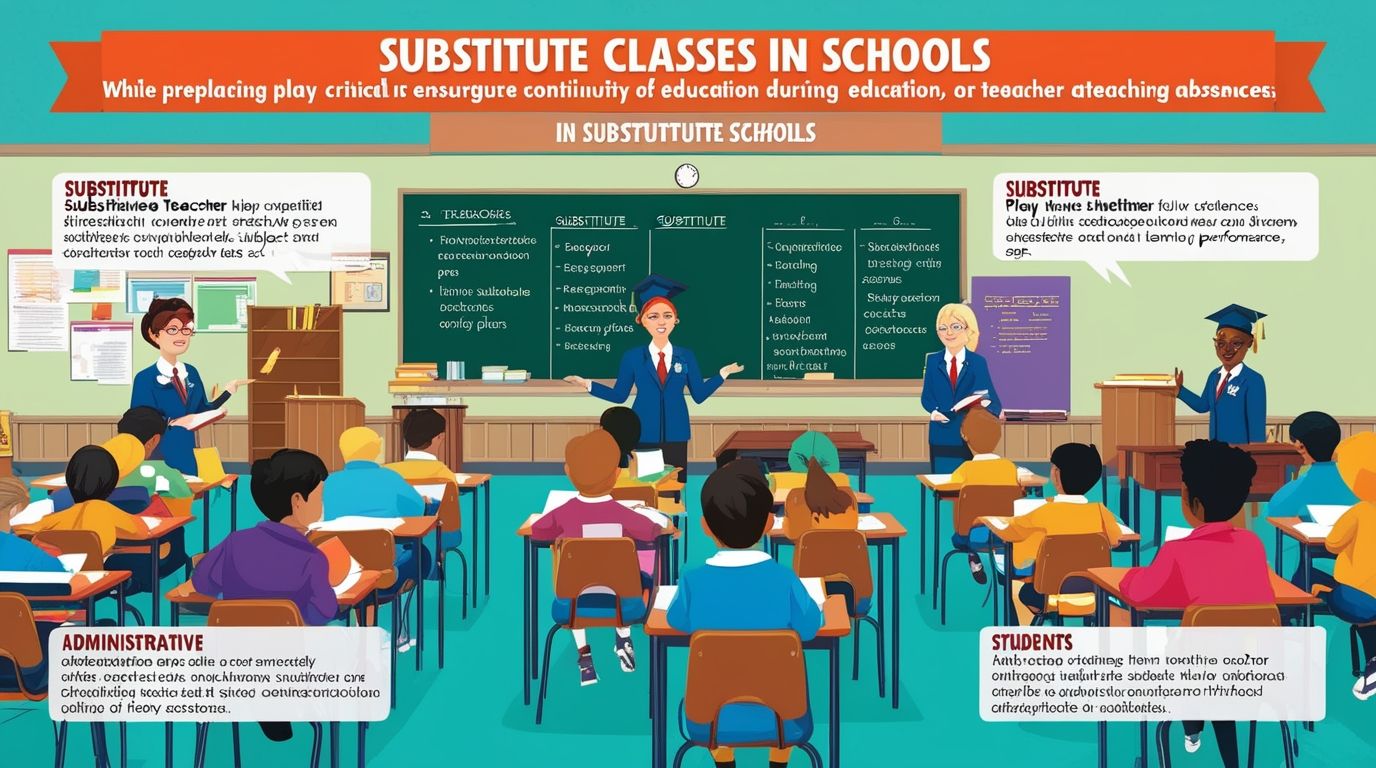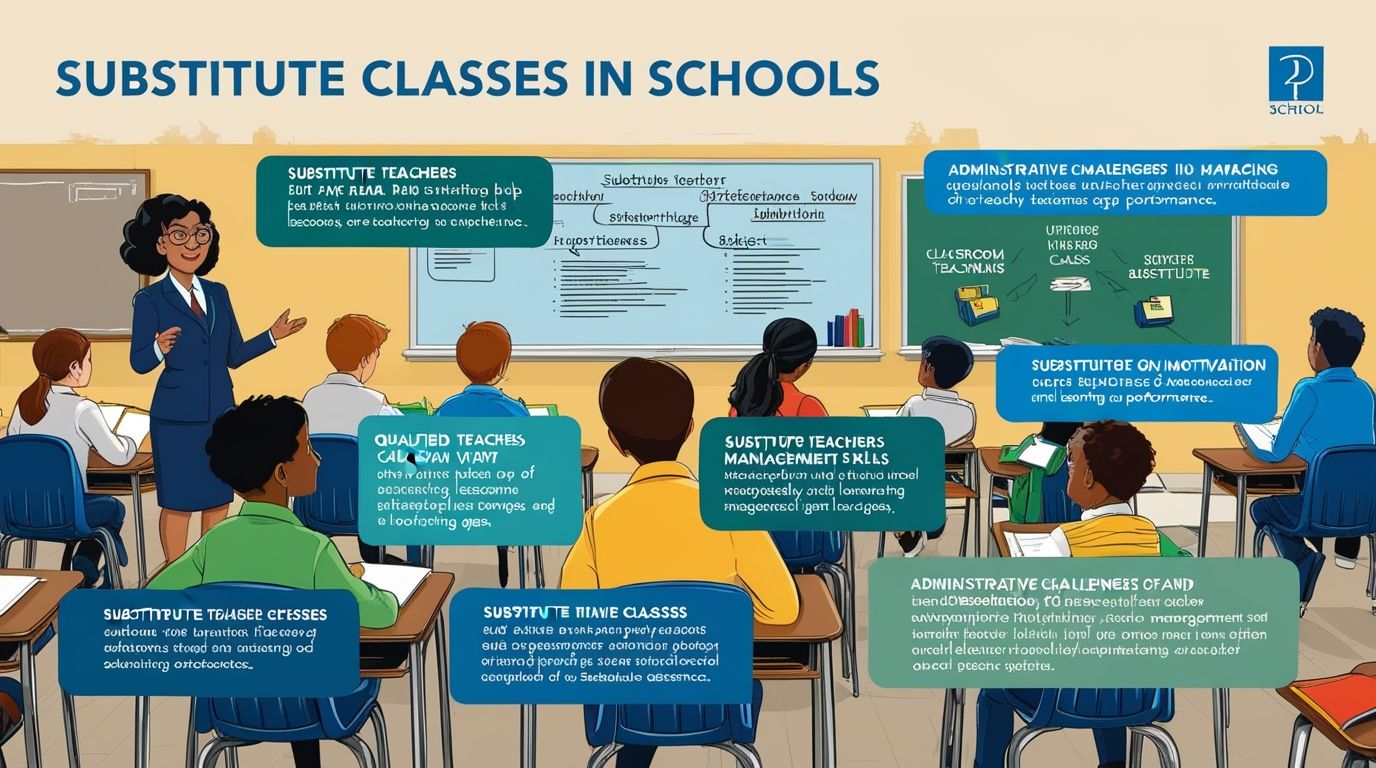Introduction
Impact of Substitute Classes in Schools, Substitute classes play a crucial role in maintaining the continuity of education when the regular teacher is unavailable. The substitute teacher steps in to ensure that students do not fall behind in their learning. Over the years, substitute teaching has evolved into a vital component of the educational system, with its own set of challenges and impacts on students, schools, and teachers. This article explores the multifaceted impact of substitute classes in schools, touching on areas such as student performance, school administration, substitute teacher effectiveness, and the overall educational experience.
1. Continuity in Learning
One of the primary purposes of substitute classes is to ensure that learning continues uninterrupted when a regular teacher is absent. This continuity is essential for maintaining the flow of the curriculum, ensuring that students do not fall behind on their learning objectives.
However, the level of continuity provided by substitute classes varies based on several factors. A qualified and well-prepared substitute can provide a seamless transition, following lesson plans closely and maintaining the regular teacher’s expectations. On the other hand, less experienced substitutes may struggle to cover the material effectively, leading to gaps in learning.
In cases where a substitute is unable to follow the lesson plan accurately, students may miss critical instruction, resulting in a domino effect of educational delays. These gaps are often more pronounced in subjects that require continuous skill development, such as mathematics or languages.
2. Student Engagement and Motivation
Student engagement in substitute classes often differs from regular classes due to the temporary nature of the teacher-student relationship. Many students may see substitute teachers as less authoritative figures compared to their regular instructors, which can result in lower levels of participation and attention.
Research suggests that students are less likely to be engaged in learning activities when a substitute teacher is present, especially if the substitute is unfamiliar with the subject matter or classroom dynamics. Inconsistent classroom management by substitutes can lead to disruptions, which further hinder the learning process.
Additionally, students may lack motivation during substitute classes if they perceive the session as less valuable or significant. This issue is exacerbated in cases where substitutes are not given enough support to engage students effectively. Teachers who lack the necessary training or experience may struggle to command the same level of respect and attention from students, leading to a drop in overall classroom productivity.
3. Substitute Teacher Preparedness and Training
The effectiveness of a substitute teacher is largely influenced by their level of preparedness and training. In many school districts, substitute teachers are not required to have extensive teaching experience or specialized knowledge in the subject areas they cover. This can lead to varying levels of instruction quality, as substitutes may not be familiar with the specific curriculum or teaching methods used by the regular teacher.
Some school systems have addressed this issue by implementing training programs for substitute teachers, providing them with essential classroom management techniques, lesson planning skills, and content knowledge. Such programs have proven effective in improving substitute teacher performance and, consequently, student outcomes during substitute classes.
Additionally, the availability of clear lesson plans and resources from the regular teacher is critical in ensuring the substitute’s success. Teachers who leave detailed instructions and materials for substitutes help minimize disruption to the learning process. On the other hand, if a teacher is absent unexpectedly and does not provide adequate guidance, the substitute may face significant challenges in maintaining the class’s academic progress.

4. Impact on Student Performance
The impact of substitute classes on student performance is a complex issue that depends on several variables, including the duration of the teacher’s absence, the subject matter, and the substitute’s qualifications. Research shows that prolonged periods with substitute teachers can have a negative effect on student achievement, especially in core subjects like mathematics and science, where continuous learning is crucial.
Short-term absences with qualified substitutes may have a minimal impact on performance. However, if substitutes are ill-prepared or inexperienced, students may fall behind, and teachers may have to spend additional time re-teaching material when they return. This creates a lag in the learning process, ultimately affecting overall academic performance.
Moreover, students with learning difficulties or those requiring specialized instruction may be disproportionately affected by substitute classes. These students often rely on the expertise of their regular teacher for tailored guidance, and substitutes may not have the necessary skills or knowledge to address their unique needs.
5. Administrative and Logistical Challenges
From an administrative perspective, organizing substitute classes can be a logistical challenge for schools. Finding a qualified substitute teacher on short notice is often difficult, particularly in rural or underfunded school districts where the pool of available substitutes is limited. Schools must also consider the cost of hiring substitutes, which can strain already tight budgets.
To address these challenges, some schools have adopted policies that allow for in-house substitutes, using existing staff members such as instructional aides or administrators to cover classes in the absence of regular teachers. While this approach may save money and provide more consistency, it can also place additional burdens on staff who may not have the expertise or time to deliver effective instruction.
In some cases, schools have resorted to canceling classes or combining multiple classes when substitutes are unavailable, further disrupting the learning environment. These stop-gap measures may help schools deal with teacher absences in the short term, but they can also negatively affect the quality of education that students receive.
6. Emotional and Social Impact on Students
Beyond academic performance, substitute classes can also have an emotional and social impact on students. The presence of a new, unfamiliar adult in the classroom can create anxiety or uncertainty, particularly for younger students or those who rely on routine and consistency.
For some students, the absence of their regular teacher can lead to feelings of detachment from the learning process, especially if they do not establish a rapport with the substitute. This detachment can manifest as disengagement or misbehavior, further disrupting the classroom environment.
On the other hand, substitute teachers can also provide positive social experiences for students. A well-trained and enthusiastic substitute can bring fresh perspectives, new teaching styles, and unique experiences to the classroom, enriching the students’ learning experience. In some cases, the presence of a substitute teacher can serve as a valuable opportunity for students to practice adaptability and resilience in unfamiliar situations.
7. Substitute Teacher-Student Relationships
The relationship between substitute teachers and students is often fleeting, but it can still have a lasting impact. A substitute who is able to quickly build rapport with students can create a positive classroom atmosphere, encouraging participation and maintaining a productive learning environment.
However, establishing such relationships can be challenging given the short-term nature of substitute teaching assignments. Substitutes who are unfamiliar with the students’ learning styles, personalities, and academic needs may find it difficult to connect with the class. This can lead to a lack of trust and respect, resulting in a less effective learning environment.
Some substitutes make an effort to learn students’ names, engage them in conversations, and show a genuine interest in their learning. These small actions can make a significant difference in how students perceive and respond to the substitute teacher.
8. Long-Term Substitutes and Their Impact
In cases where a teacher is absent for an extended period, schools may hire a long-term substitute to take over the class. Long-term substitutes are typically more integrated into the school community and may have more opportunities to build relationships with students and collaborate with other teachers.
While long-term substitutes can provide more stability than short-term substitutes, their effectiveness still depends on their qualifications, training, and support from the school. A well-prepared long-term substitute can effectively take over the regular teacher’s duties, maintaining continuity in the curriculum and fostering a positive learning environment. However, if the long-term substitute lacks the necessary skills or resources, the impact on student learning can be significant.
Conclusion
Substitute classes play a vital role in ensuring that education continues despite teacher absences. However, their impact on student performance, engagement, and overall school dynamics can vary greatly depending on the preparedness and qualifications of the substitute teacher, the duration of the absence, and the support provided by the school.
While substitute teaching can present challenges, schools can take steps to mitigate the negative effects by investing in substitute teacher training, providing clear lesson plans, and ensuring that substitutes have the necessary resources to succeed. Ultimately, the goal is to create a learning environment where students can thrive, regardless of whether their regular teacher is present.
References
- Hartman, D. (2018). The Role of Substitute Teachers in Classroom Continuity. Journal of Educational Research, 12(4), 543-560.
- Smith, L., & Yoder, P. (2019). Student Engagement and Substitute Teaching: A Case Study. Educational Leadership, 76(2), 34-42.
- Johnson, R. (2020). Improving Substitute Teacher Effectiveness: Training and Support in Schools. Teaching and Learning Review, 8(1), 89-101.
- Walker, K. (2021). The Impact of Substitute Classes on Student Learning and School Dynamics. International Journal of Educational Studies, 15(3), 210-225.

4 thoughts on “Impact of Substitute Classes in Schools”
Comments are closed.